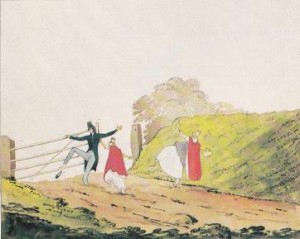For the most part, Great Britain is a soggy place. Surrounded by water, rain is almost a way of life there. But what about snow; now that is an entirely different matter! Snow is much more unlikely even though many of my favorite Regencies are set in a country house at Christmas smothered in snow, giving the hero and heroine plenty of time to flirt, argue, ignore and fall in love with each other.
I am hoping that one of my next stories might be a Christmas Regency, so I decided to research winter apparel. I specifically remember that in these lovely stories, when they ventured out in the snow to get the Yule log, invariably we are told that the ladies rushed to get their pattens. I never really thought much about pattens, assuming it was a sort of a rubber overshoe that would fit over a sturdy walking boot to protect it from ruination, much like our mothers used to wear. Wow, was I wrong!

These my friends are pattens; and they weren’t for snow at all!
This pair is made of flat metal rings which made contact with the ground and the ring was attached to a metal plate nailed into the wooden sole. Can you imagine trying to keep your balance while wearing such things?
And when worn on stone floors they made such loud clatter that churches made ladies remove them when they entered. Many churches banned them altogether!
Jane Austen herself wrote of the “ceaseless clink of pattens” when referring to life in Bath; as we know being a perpetually rainy and damp part of England.
 They were clumsy platforms that raised the shoe a few inches from the ground to protect the hem of a gown and they were used by men as well as women, in the country on muddy, rutted lanes and in London when walking on horse infested pavement.
They were clumsy platforms that raised the shoe a few inches from the ground to protect the hem of a gown and they were used by men as well as women, in the country on muddy, rutted lanes and in London when walking on horse infested pavement.
 Pattens date back to the 14th century. Only the rich would have been able to afford these porcelain china pattens worn to protect their long and ornate robes.
Pattens date back to the 14th century. Only the rich would have been able to afford these porcelain china pattens worn to protect their long and ornate robes.
 These are huge pattens worn by Turkish women in 1738.
These are huge pattens worn by Turkish women in 1738.

In the 17th century when ladies shoes were commonly made with an upper of figured silk or brocade that almost any venture out necessitated the use of this patten to protect the shoe as well as the hem of the gown. This is how the shoes fit into them and the metal ring would have been attached to the wooden platform under the shoe.
 By the 18th and 19th centuries, men’s shoes had thicker soles, hemlines rose, and as roadways and transportation improved pattens were abandoned by the ladies as well and were worn only by the working class men and women as they went about their duties.
By the 18th and 19th centuries, men’s shoes had thicker soles, hemlines rose, and as roadways and transportation improved pattens were abandoned by the ladies as well and were worn only by the working class men and women as they went about their duties.
In “A Memoir of Jane Austen,” James Edward Austen Leigh wrote about his aunts Cassandra and Jane:
The other peculiarity was that when the roads were dirty the sisters took long walks in pattens. This defense against wet and dirt is now seldom seen. The few that remain are banished from good society and employed only in menial work…
So, the next time you read about the ladies donning their pattens to venture out of doors, I dare you not to smile as you picture it!
The Woodlanders
Arrived at the entrance to a long flat lane, which had taken the spirit out of many a pedestrian in times when, with the majority, to travel meant to walk, he saw before him the trim figure of a young woman in pattens, journeying with that steadfast concentration which means purpose and not pleasure. He was soon near enough to see that she was Marty South. Click, click, click went the pattens; and she did not turn her head.
She had, however, become aware before this that the driver of the approaching gig was Giles. She had shrunk from being overtaken by him thus; but as it was inevitable, she had braced herself up for his inspection by closing her lips so as to make her mouth quite unemotional, and by throwing an additional firmness into her tread.
“Why do you wear pattens, Marty? The turnpike is clean enough, although the lanes are muddy.”
“They save my boots.”
“But twelve miles in pattens–’twill twist your feet off. Come, get up and ride with me.”
She hesitated, removed her pattens, knocked the gravel out of them against the wheel, and mounted in front of the nodding specimen apple-tree….
Thomas Hardy
She lost her pattens in the muck
& Roger in his mind
Considered her misfortune luck
To show her he was kind
He over hitops fetched it out
& cleaned it for her foot…
From the Middle Period Poems of John Clare (1820s)
Originally posted 2013-01-14 10:00:00.